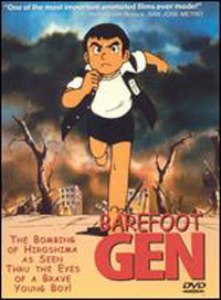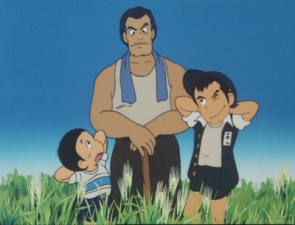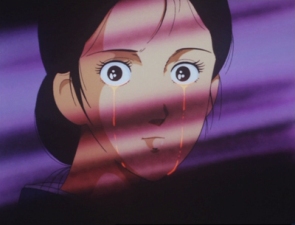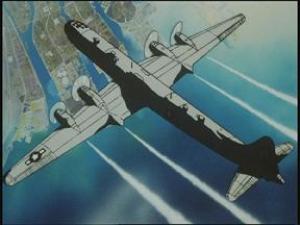
BAREFOOT GEN
Or How I Learned to Stop Worrying and Love the Bomb

 Review by: M.H. “Glows in the Dark” Torringjan
Review by: M.H. “Glows in the Dark” Torringjan
Length: 83 minutes
Genre: War
Watched: Entire movie, badly subbed
I knew this couldn’t be as depressing as Grave of the Fireflies (we have provided as a public service pictures of cute kittens to soften the blow of this film). Grave of the Fireflies couldn’t have been more depressing if it had featured a month-old bunny rabbit dying of leukemia (which I wouldn’t have put past them). I knew that this was a highly-regarded World War II anime film, and being the anime-and-WWII enthusiast that I am, I decided to give it a shot. While it wasn’t quite what I would have expected from something like GotF, it did get the message across effectively.
Plot summary: Autobiographical story of a child living in Hiroshima around the Summer of 1945, around the end of World War II. Gen Nakaoka’s family are a group of peace-loving citizens who are opposed to the war because of the damage it is doing to the nation and the innocent citizens. This opinion, however, is not echoed by the leaders of the country, who believe that the nation can win (hmmm, sound familiar?). Everything changes, however, on August 6th, the United States launched an attack with its newest weapon on a defenseless populace, and the aftermath would change Gen’s life forever.
 Artwork: I’ve seen some pretty old films, and this’s one of them. The movie was originally a manga released in the early 1970’s, and the movie was released in 1983, and the animation style certainly shows it. The backgrounds aren’t all that bad, but overall, the character design and general appearance of the film looks about on par for that year. Even the artwork of the nuclear (remember, that’s “new-CLEE-ur”) blast shows its age. The images presented, however, are striking and memorable depictions of the blast and its effect on the people living in Hiroshima. However, I still would question whether the animation style used really does justice to the reality of the horrors that happened that day.
Artwork: I’ve seen some pretty old films, and this’s one of them. The movie was originally a manga released in the early 1970’s, and the movie was released in 1983, and the animation style certainly shows it. The backgrounds aren’t all that bad, but overall, the character design and general appearance of the film looks about on par for that year. Even the artwork of the nuclear (remember, that’s “new-CLEE-ur”) blast shows its age. The images presented, however, are striking and memorable depictions of the blast and its effect on the people living in Hiroshima. However, I still would question whether the animation style used really does justice to the reality of the horrors that happened that day.
Music: Extremely unremarkable. While the movie makes good use of silence at some points, it also uses generic music, about on par with when it was made. While it does set the mood appropriately, it isn’t anything really special.
 Characters: Gen Nakaoka is a normal, spunky boy who lives with his family in a small house in Hiroshima. As with all children, he loves his parents and will do anything that he thinks will improve their lot in life. He acts as a role model for his little brother, Shinji, who acts as his partner in crime almost all the time. Gen’s father is a proud man who works hard to protect and support his family, but is vocally critical of the war, which has landed their family in trouble with the rest of the city. He is proud of his children and deeply cares for his wife and their unborn child. Shinji’s mother, Kimei, is the caring matriarch who looks out for her children and will do what it takes to allow them to survive this trying time in the nation’s history. Eiko is Shinji’s sister, who acts as crowd control for Shinji and Gen, keeping them in line while their mother is weak and taking care of the baby.
Characters: Gen Nakaoka is a normal, spunky boy who lives with his family in a small house in Hiroshima. As with all children, he loves his parents and will do anything that he thinks will improve their lot in life. He acts as a role model for his little brother, Shinji, who acts as his partner in crime almost all the time. Gen’s father is a proud man who works hard to protect and support his family, but is vocally critical of the war, which has landed their family in trouble with the rest of the city. He is proud of his children and deeply cares for his wife and their unborn child. Shinji’s mother, Kimei, is the caring matriarch who looks out for her children and will do what it takes to allow them to survive this trying time in the nation’s history. Eiko is Shinji’s sister, who acts as crowd control for Shinji and Gen, keeping them in line while their mother is weak and taking care of the baby.
Plot: It’s a historical film, so very much in the same way that you watch Titanic knowing that something bad is going to happen (or good, depending on how you feel about Leonardo DiCaprio), you just know that somebody’s not getting out of this one alive. Other than that, the plot runs along the lines of a slice-of-life drama with strong anti-war tones. While the topic of this film is along somewhat similar lines as Grave, the portrayal is slightly different. While Grave has an almost non-stop downtrodden note to it, this movie takes some time out to show the lighter side of life, the victories against the backdrop of death and violence. The childrens’ situation in Grave keeps getting worse and worse as the movie progresses, while the theme of this film is slightly more optimistic. This is a possible reason that this film as a whole didn’t have as much of an emotional impact. In my opinion, anyway.
 CHICKS!!! Are you even reading this section? This is hardly the time to think about hot girls with large breasts toting what very well could be either rapid-fire laser pistols or an extendable sword and wearing nothing but glasses and a bunny suit! Whenever there’s a war film, I just keep thinking about little Setsuko, and that’s a surefire libido killer! Just move on!
CHICKS!!! Are you even reading this section? This is hardly the time to think about hot girls with large breasts toting what very well could be either rapid-fire laser pistols or an extendable sword and wearing nothing but glasses and a bunny suit! Whenever there’s a war film, I just keep thinking about little Setsuko, and that’s a surefire libido killer! Just move on!
Overall: While this film has been touted by many critics as the greatest WWII flim ever made, I would question that. While it did have a strong anti-war message couched in the images of the lives of the people who lived through one of the greatest tragedies in human history, and the images were striking and told by someone who actually *did* live through that time and place, I would question whether its emotional impact was as strong as some other World War II films. It is good and does strike to the heart of the “war is dumb and harms innocent people” issue, but the technical issues of the film leave it falling a little bit short of others in its genre.
 IN A NUTSHELL
IN A NUTSHELL
+ Strong anti-war message
+ True-to-life depiction
+ Slightly more positive theme
- Style is dated
- Less emotional impact than expected
Final score: 8/10
Return to Index


 Review by: M.H. “Glows in the Dark” Torringjan
Review by: M.H. “Glows in the Dark” Torringjan Artwork: I’ve seen some pretty old films, and this’s one of them. The movie was originally a manga released in the early 1970’s, and the movie was released in 1983, and the animation style certainly shows it. The backgrounds aren’t all that bad, but overall, the character design and general appearance of the film looks about on par for that year. Even the artwork of the nuclear (remember, that’s “new-CLEE-ur”) blast shows its age. The images presented, however, are striking and memorable depictions of the blast and its effect on the people living in Hiroshima. However, I still would question whether the animation style used really does justice to the reality of the horrors that happened that day.
Artwork: I’ve seen some pretty old films, and this’s one of them. The movie was originally a manga released in the early 1970’s, and the movie was released in 1983, and the animation style certainly shows it. The backgrounds aren’t all that bad, but overall, the character design and general appearance of the film looks about on par for that year. Even the artwork of the nuclear (remember, that’s “new-CLEE-ur”) blast shows its age. The images presented, however, are striking and memorable depictions of the blast and its effect on the people living in Hiroshima. However, I still would question whether the animation style used really does justice to the reality of the horrors that happened that day. Characters: Gen Nakaoka is a normal, spunky boy who lives with his family in a small house in Hiroshima. As with all children, he loves his parents and will do anything that he thinks will improve their lot in life. He acts as a role model for his little brother, Shinji, who acts as his partner in crime almost all the time. Gen’s father is a proud man who works hard to protect and support his family, but is vocally critical of the war, which has landed their family in trouble with the rest of the city. He is proud of his children and deeply cares for his wife and their unborn child. Shinji’s mother, Kimei, is the caring matriarch who looks out for her children and will do what it takes to allow them to survive this trying time in the nation’s history. Eiko is Shinji’s sister, who acts as crowd control for Shinji and Gen, keeping them in line while their mother is weak and taking care of the baby.
Characters: Gen Nakaoka is a normal, spunky boy who lives with his family in a small house in Hiroshima. As with all children, he loves his parents and will do anything that he thinks will improve their lot in life. He acts as a role model for his little brother, Shinji, who acts as his partner in crime almost all the time. Gen’s father is a proud man who works hard to protect and support his family, but is vocally critical of the war, which has landed their family in trouble with the rest of the city. He is proud of his children and deeply cares for his wife and their unborn child. Shinji’s mother, Kimei, is the caring matriarch who looks out for her children and will do what it takes to allow them to survive this trying time in the nation’s history. Eiko is Shinji’s sister, who acts as crowd control for Shinji and Gen, keeping them in line while their mother is weak and taking care of the baby. CHICKS!!! Are you even reading this section? This is hardly the time to think about hot girls with large breasts toting what very well could be either rapid-fire laser pistols or an extendable sword and wearing nothing but glasses and a bunny suit! Whenever there’s a war film, I just keep thinking about little Setsuko, and that’s a surefire libido killer! Just move on!
CHICKS!!! Are you even reading this section? This is hardly the time to think about hot girls with large breasts toting what very well could be either rapid-fire laser pistols or an extendable sword and wearing nothing but glasses and a bunny suit! Whenever there’s a war film, I just keep thinking about little Setsuko, and that’s a surefire libido killer! Just move on! IN A NUTSHELL
IN A NUTSHELL